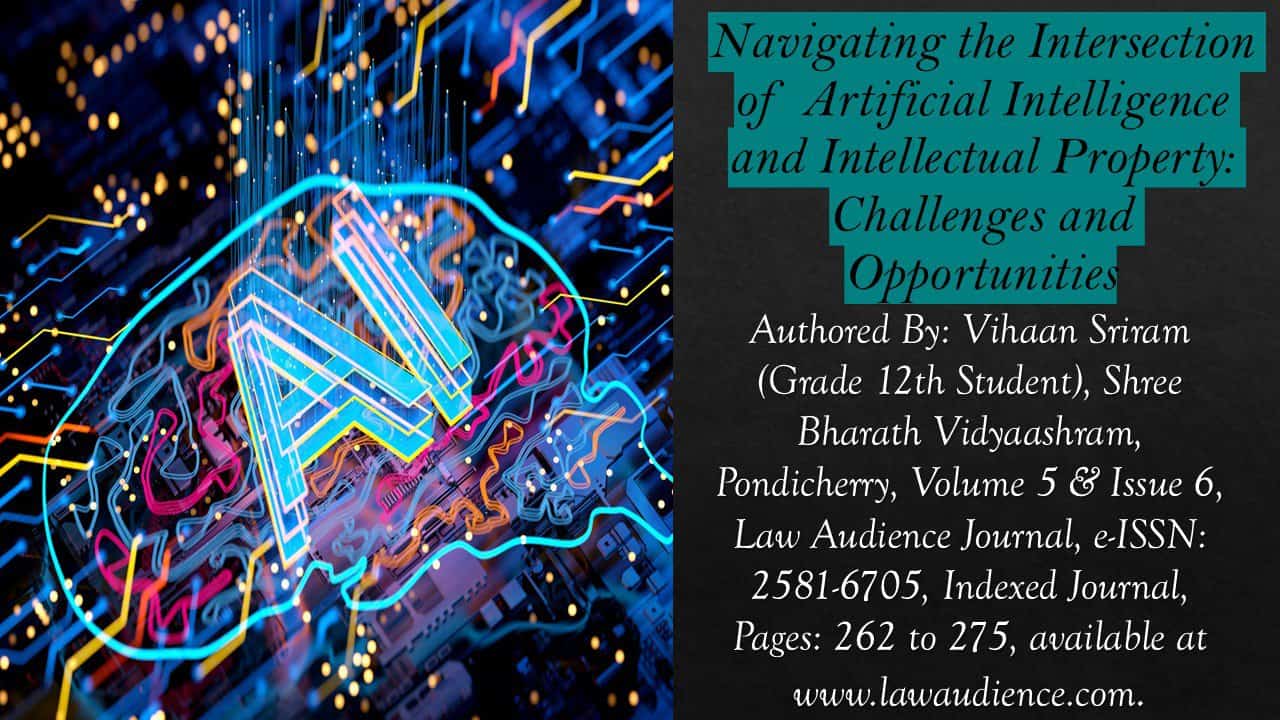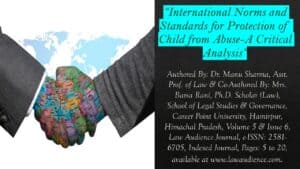Click here to download the full paper (PDF)
Authored By: Vihaan Sriram (Grade 12th Student), Shree Bharath Vidyaashram, Pondicherry,
Click here for Copyright Policy.
I. INTRODUCTION:
“The rapid advancements in Artificial Intelligence (AI) have reshaped numerous industries, enhancing efficiency and innovation. AI-driven technologies, ranging from machine learning algorithms to neural networks, are increasingly used to solve complex problems, automate tasks, and improve decision-making processes. While AI holds immense potential in fields such as healthcare, finance, and transportation, its intersection with intellectual property (IP) law presents unprecedented legal and ethical challenges, including questions of authorship, ownership, and accountability in an era of machine-generated creativity. Intellectual property law—comprising patents, copyrights, trademarks, and trade secrets—exists to protect creative works, inventions, and proprietary knowledge. However, as AI systems independently generate creative works, invent new technologies, and provide innovative solutions, traditional IP frameworks face significant challenges in determining ownership and rights.
A central question is whether AI can be recognized as an inventor or creator under existing IP laws. Traditional IP law assumes that only human beings can hold rights to creations or inventions. However, AI’s growing ability to autonomously generate content raises critical concerns regarding ownership, accountability, and legal recognition. This paper explores the role of AI in creative and innovative processes, evaluates existing IP laws’ limitations, analyses key case studies, and proposes potential legal reforms to address these emerging challenges”.
II. THE ROLE OF AI IN CREATIVE AND INNOVATIVE PROCESSES:
Historically, AI functioned primarily as a tool to assist human creators. Machine learning algorithms have long supported artists, musicians, and writers in generating music, visual art, and literature. However, recent advancements in AI have led to the creation of works that require minimal human intervention, pushing the boundaries of conventional authorship and inventorship. In patent law, AI-driven systems can analyze vast amounts of scientific literature and technical data to identify novel inventions. AI can design new products and processes autonomously, challenging the notion of human inventorship. The question arises: should an AI system be credited as the inventor of a patent? Similarly, in copyright law, AI-generated paintings, music, and novels have entered mainstream markets. For example, AI-generated art has gained commercial value, with works auctioned for significant sums. This raises the debate on whether AI should be legally recognized as an author or whether its human programmers should retain ownership. As AI continues to evolve and autonomously generate new works, legal systems must redefine concepts of authorship, inventorship, and ownership. For instance, AI-generated novels and paintings, such as “The Next Rembrandt,” have challenged traditional IP laws, prompting legal debates on ownership rights.
III. CURRENT LEGAL FRAMEWORK AND AI-GENERATED IP:
III.I INTERNATIONAL PERSPECTIVES ON AI AND IP LAW:
Most intellectual property laws worldwide are founded on the assumption that a natural person—a human being—must be recognized as the creator or inventor. This principle is embedded in international agreements such as the Berne Convention for the Protection of Literary and Artistic Works and the Patent Cooperation Treaty, both of which emphasize human authorship and inventorship. However, landmark legal cases have tested these traditional frameworks, particularly as AI systems become more capable of autonomously generating innovative solutions, artworks, and literary compositions. For instance, the DABUS case, which involved an AI system named DABUS creating patentable inventions, challenged the long-standing assumption that only human beings can be inventors. Despite multiple rejections by the US Patent and Trademark Office (USPTO), the European Patent Office (EPO), and the UK Intellectual Property Office, the case ignited debates on whether AI should be granted inventorship status. Meanwhile, in China, courts have recognized AI-assisted works as eligible for copyright protection, provided there is sufficient human involvement in the creative process. Japan has taken a more progressive approach by exploring legislative amendments that could allow AI-generated works to receive copyright protection under a new classification system that differentiates between fully autonomous AI-generated content and AI-assisted works. Similarly, South Korea is studying potential reforms that could grant limited rights to AI-generated inventions, particularly in cases where human oversight is demonstrably minimal. As AI technology continues to evolve, legal scholars and policymakers worldwide are grappling with the implications of recognizing AI as a legitimate contributor to innovation and creativity. Some advocate for a hybrid model that grants co-authorship or co-inventorship status to AI and its human developers, while others argue for the creation of a new category of intellectual property rights specifically designed for AI-generated works. These ongoing discussions highlight the urgent need for harmonized international policies that balance technological progress with legal certainty.
III.II CASE STUDY: DABUS AND AI INVENTORSHIP:
One of the most significant cases concerning AI inventorship involves DABUS (Device for the Autonomous Bootstrapping of Unified Sentience), an AI system developed by Dr. Stephen Thaler. This case has significantly influenced global discussions on whether AI should be granted legal recognition as an inventor and has set precedents for future AI-related intellectual property (IP) policies. In multiple jurisdictions, patent applications were filed listing DABUS as the inventor, describing innovations such as an improved food container with fractal surfaces for better grip and heat transfer, and a flashing light system designed for attracting attention in emergencies. These inventions were generated autonomously by the AI, with no human directly involved in the creative process. The applications were submitted in various countries, including the United States, United Kingdom, European Union, Australia, and South Africa, sparking a worldwide debate on whether an AI system could be legally recognized as an inventor. However, the patent offices in the United States, United Kingdom, and European Union rejected the applications, asserting that only human beings can be named as inventors under existing laws.
• The UK Supreme Court (2023) ruled that a patent requires a human inventor, upholding the traditional definition of inventorship as outlined in the UK Patents Act 1977. The court emphasized that the law does not provide for non-human entities to hold patent rights, reinforcing the importance of human ingenuity in the patent process.
• The US Patent and Trademark Office (USPTO) similarly rejected the application, citing the Patent Act, which explicitly requires inventors to be “natural persons.” The US Court of Appeals for the Federal Circuit (2022) upheld this decision, reinforcing the notion that AI cannot legally be considered an inventor under US law.
• The European Patent Office (EPO) also rejected the application, reaffirming that patent law in Europe mandates a human inventor. The EPO reasoned that allowing AI inventorship could lead to significant legal ambiguities, including issues surrounding ownership, accountability, and enforcement of patent rights.
Despite these setbacks, the DABUS case led to divergent approaches in different parts of the world.
• South Africa became the first country to grant a patent listing DABUS as an inventor in 2021, demonstrating a willingness to embrace AI-generated innovations within the legal framework. However, legal scholars argue that this may be due to procedural differences rather than a fundamental shift in patent law interpretation.
• Australia initially granted the patent, ruling in favour of AI inventorship. However, this decision was later overturned by the Full Federal Court of Australia (2022), which ruled that under the Patents Act 1990, an inventor must be a natural person.
IV. IMPLICATIONS AND THE NEED FOR REFORM:
These rulings highlight the limitations of existing legal frameworks in accommodating AI-generated innovations. The case has raised important philosophical, ethical, and legal questions regarding AI’s role in creativity and innovation. Some key concerns include:
• Who owns an AI-generated invention? If AI were to be recognized as an inventor, the question of ownership remains unresolved. Would rights belong to the AI’s developer, the entity using the AI, or the AI itself?
• How should AI-generated patents be enforced? If an AI system generates an invention, who would be held accountable in cases of patent infringement?
• Would allowing AI inventorship encourage or hinder innovation? Some argue that granting patents to AI-generated inventions could incentivize AI research and technological progress, while others warn that it may lead to monopolization of AI-driven innovation by corporations.
Given these complexities, legal scholars and policymakers are exploring potential reforms to accommodate AI-generated patents, such as:
1. Creating a “Hybrid Inventorship” Model – Recognizing AI as a co-inventor alongside human contributors. This approach would acknowledge AI’s role in innovation while ensuring human oversight and accountability.
2. Introducing AI-Specific IP Protections – Developing a new legal category for AI-generated inventions, separate from traditional patent law, with tailored guidelines on ownership, licensing, and enforcement.
3. Revising International Patent Laws – Encouraging global cooperation through organizations like WIPO (World Intellectual Property Organization) to develop harmonized standards for AI-related IP.
V. THE ONGOING DEBATE:
The DABUS case has ignited ongoing debates among lawmakers, patent offices, AI developers, and legal scholars. While current laws still favour human-only inventorship, the rapid advancements in AI suggest that legal frameworks may need to evolve. Whether through legislative amendments, judicial reinterpretation, or entirely new legal frameworks, the question of AI inventorship remains one of the most pressing challenges in modern IP law.
VI. AI AND COPYRIGHT LAW: CHALLENGES IN RECOGNIZING AI-GENERATED WORKS:
In copyright law, authorship traditionally implies human creativity and intent—elements that have long been considered essential for obtaining copyright protection. However, the emergence of AI-generated works has fundamentally challenged this notion, leading to legal and philosophical debates about whether AI can be considered an author. One of the most well-known cases highlighting this issue is the AI-generated painting “Edmond de Belamy”, which was auctioned for over $432,000 in 2018. The artwork was created using a Generative Adversarial Network (GAN), trained on thousands of historical paintings to generate a unique composition. The sale of the artwork ignited debates on whether copyright protection should be extended to AI-generated works or remain restricted to human creators.
VII. THE U.S. COPYRIGHT OFFICE’S STANCE ON AI-GENERATED WORKS:
In 2019, the U.S. Copyright Office (USCO) ruled that non-human entities cannot be granted copyright protection, reaffirming that copyright law necessitates human authorship. This ruling has been reiterated in several cases, including:
• Thaler vs. U.S. Copyright Office (2022): Dr. Stephen Thaler, the creator of the AI system “Creativity Machine,” attempted to register an AI-generated artwork for copyright protection. The USCO rejected the claim, stating that copyright law requires a human author who exercises creative control. The U.S. District Court for the District of Columbia (2023) upheld this decision, reinforcing that AI-generated works without human authorship are ineligible for copyright.
• Naruto vs. Slater (2018): Although not an AI-related case, the “Monkey Selfie” case was frequently cited in discussions about AI authorship. The U.S. courts ruled that non-human entities (such as animals) cannot own copyrights, setting a precedent that has influenced decisions regarding AI-generated works.
The current legal framework in the U.S. aligns with these rulings, emphasizing that copyright must be attributed to a human being who plays a meaningful role in the creative process. However, this approach is increasingly being questioned as AI-generated content becomes more sophisticated and widespread.
VIII. DIVERGING GLOBAL PERSPECTIVES ON AI AND COPYRIGHT:
While the U.S. maintains a strict human authorship requirement, other jurisdictions are adopting more flexible approaches:
• China: In 2020, a Chinese court ruled in favour of granting copyright protection to an AI-generated article produced by Tencent’s Dream writer AI, stating that it contained sufficient “original intellectual input” from human programmers. This ruling suggests that AI-assisted works could be eligible for copyright protection if a human plays a substantial role in guiding the AI.
• European Union: The EU Copyright Directive (2019) does not explicitly address AI-generated works but emphasizes that copyright protection should extend only to original works that reflect the creator’s intellectual effort. The EU has, however, opened discussions on whether AI-assisted works should be granted a new form of copyright recognition.
• United Kingdom: The UK takes a unique approach, as its Copyright, Designs and Patents Act (1988) explicitly states that for computer-generated works, “the author shall be taken to be the person by whom the arrangements necessary for the creation of the work are undertaken.” This provides a potential legal basis for recognizing AI-generated works, provided that a human is responsible for guiding the AI’s creative process.
These diverging global perspectives highlight the lack of international consensus on how AI-generated works should be treated under copyright law.
IX. ETHICAL AND ECONOMIC IMPLICATIONS OF AI IN IP LAW:
IX.I RECENT AI-IP DISPUTES:
Recent high-profile disputes over AI-generated works underscore the urgency for legal clarity. In 2022, an AI-generated artwork submitted to a prestigious digital art competition sparked controversy when the human entrant was awarded the prize despite minimal creative input. Similarly, disputes over AI-created music compositions have raised concerns about revenue-sharing models and attribution rights among artists and AI developers.
The rise of AI-generated works also raises significant ethical and economic concerns:
• Fairness in Intellectual Property Ownership: If AI-generated works are owned by corporations that develop AI systems, it could lead to monopolization of intellectual property, limiting accessibility and innovation.
• Accountability and Liability: If AI infringes upon existing patents or copyrights, who should be held accountable—the AI itself, its developer, or the entity using it?
• The Future of Human Creativity: As AI-generated content floods markets, there is a risk of devaluing human-created works, potentially affecting industries reliant on traditional artistic and inventive processes.
X. PROPOSED LEGAL REFORMS AND FUTURE IMPLICATIONS:
As artificial intelligence continues to evolve, policymakers and legal scholars face the challenge of developing governance models that balance technological innovation, ethical considerations, and intellectual property protection. The question of how AI-generated works should be treated within IP law has sparked global debate, leading to the emergence of several potential governance models and policy recommendations aimed at adapting legal frameworks to the AI era.
XI. AI GOVERNANCE MODELS AND POLICY RECOMMENDATIONS:
To address the complexities of AI-generated intellectual property, experts have proposed different governance models, each with distinct legal, ethical, and economic implications:
1. The AI-Assisted IP Model – This model recognizes AI as a collaborative tool rather than an independent creator. Under this framework, copyrights and patents remain with human inventors or authors, while acknowledging AI’s contribution to the creative or inventive process. This model aligns with current global legal standards, ensuring that AI-generated innovations still have a human entity responsible for ownership and accountability.
2. The AI-Owned IP Model – A radical approach suggesting that AI itself could be granted legal personhood or ownership rights over its creations. Proponents argue that as AI becomes increasingly autonomous, it may be necessary to create a legal identity for AI systems, like how corporations are treated as legal entities. However, this model presents numerous challenges, including accountability, liability, and the question of who would benefit financially from AI-owned intellectual property.
3. The Public Domain Model – This model advocates that AI-generated works should automatically enter the public domain, making them freely accessible to prevent monopolization by corporations. Supporters argue that because AI does not possess creativity in the human sense, its outputs should not be subject to restrictive intellectual property laws. However, opponents fear that this approach could discourage investment in AI-driven innovation, as companies may be less willing to develop advanced AI if they cannot secure legal protection for its creations.
4. The Hybrid IP Model – A proposed compromise that introduces co-authorship or co-inventorship between AI and its human operators. This model would allow AI-generated works to be protected under a modified copyright and patent framework, ensuring that both AI developers and human users retain shared rights. Such an approach could pave the way for fair attribution while maintaining human oversight in the intellectual property process.
XII. KEY LEGAL AND ETHICAL CONSIDERATIONS IN AI GOVERNANCE:
Regardless of which model is adopted, any legal reforms must address several key concerns:
• Ownership and Accountability – If AI contributes significantly to an invention or creative work, who should own the rights? The AI’s developer, the user operating it, or the AI itself?
• Incentives for Innovation – How can legal frameworks encourage investment in AI-driven creativity while ensuring fair distribution of IP rights?
• Preventing Corporate Monopolization – Without proper regulation, AI-generated IP could become concentrated in the hands of large corporations, stifling competition and limiting access to AI-generated innovations.
• Ethical and Moral Responsibility – AI has no moral compass or ethical decision-making ability. Should human operators be legally responsible for the consequences of AI-generated works?
XIII. POTENTIAL REFORMS FOR AI AND INTELLECTUAL PROPERTY LAW:
Given the rapid advancements in AI, legal frameworks must evolve to ensure a balanced approach that fosters innovation while preventing potential legal and economic imbalances. The following policy recommendations outline some possible reforms:
1. Recognizing AI as a Contributor Rather Than an Inventor:
Instead of granting AI full inventorship or authorship, legal systems could introduce a “co-inventor” or “AI-assisted invention” category. This approach would acknowledge AI’s role in the creative and inventive process while maintaining a human-centric framework for accountability.
2. Establishing AI-Specific IP Protection:
A new category of intellectual property rights tailored to AI-generated works could be introduced, distinct from traditional copyrights and patents. This framework could outline specific guidelines on ownership, licensing, and enforcement, ensuring that AI-driven innovation is recognized while preventing potential misuse.
Some proposals for AI-specific IP laws include:
• Creating a limited-duration protection system for AI-generated works, allowing temporary exclusivity before placing them in the public domain.
• Requiring clear documentation of AI involvement in the creative process to determine eligibility for protection.
• Establishing licensing models that allow AI-generated works to be commercially exploited while ensuring fair compensation for AI developers.
3. Revising Copyright Laws for AI-Generated Works:
As AI becomes more involved in content creation, copyright laws must be updated to address the distinction between AI-assisted and fully AI-generated works. Some possible revisions include:
• Granting copyright protection to human creators who use AI tools, provided they demonstrate meaningful creative input.
• Introducing mandatory AI disclosure rules, requiring companies and artists to label AI-generated works transparently.
• Establishing royalty-sharing mechanisms where AI developers and human users can benefit from AI-assisted creations.
4. Global Harmonization of AI and IP Laws:
Because AI-driven innovation transcends national borders, international cooperation is essential to standardize AI-related IP laws. Organizations like the World Intellectual Property Organization (WIPO), the European Patent Office (EPO), and the United Nations (UN) should lead efforts to develop global policies that:
• Ensure uniform AI governance principles across jurisdictions.
• Prevent legal loopholes that allow companies to exploit inconsistencies in national laws.
• Establish an international dispute resolution mechanism for AI-related intellectual property conflicts.
XIV. EMERGING LEGAL AND TECHNOLOGICAL TRENDS SHAPING AI GOVERNANCE:
As AI governance continues to evolve, several emerging trends could influence future legal frameworks:
1. AI in Creative Industries – The use of AI in music, literature, film, and digital art is expanding rapidly, requiring urgent legal clarity on copyright protections.
2. Blockchain and AI IP Protection – Blockchain technology is being explored as a way to track AI-generated content ownership and ensure transparency in intellectual property rights.
3. AI-Generated Deepfakes and Ethical Concerns – The rise of deepfake technology raises questions about whether AI-created content should be regulated separately from traditional IP laws.
4. AI and Patent Law Evolution – As AI-driven scientific discoveries accelerate, some experts propose creating a new AI patent classification system to distinguish between AI-assisted and fully autonomous inventions.
XV. CONCLUSION:
The intersection of artificial intelligence and intellectual property law presents complex legal, ethical, and economic challenges. Current IP frameworks, designed for human inventors and authors, struggle to accommodate AI-generated works. Landmark cases, such as DABUS and AI-generated art sales, illustrate the pressing need for legal reforms. As AI’s role in creativity and innovation expands, a balanced approach is required—one that fosters technological advancement while protecting the rights and contributions of human creators. One potential solution is a hybrid IP model that grants partial recognition to AI-generated works while maintaining human oversight in the creative process. By adapting intellectual property laws to the realities of AI-driven innovation, we can create a legal landscape that promotes fair ownership, accountability, and continued progress in the digital age.
Cite this articles as:
VIHAAN SRIRAM, “Navigating the Intersection of Artificial Intelligence and Intellectual Property: Challenges and Opportunities” Vol.5 & Issue 6, Law Audience Journal (e-ISSN: 2581-6705), Pages 262 to 275 (18th Feb 2025), available at https://www.lawaudience.com/navigating-the-intersection-of-artificial-intelligence-and-intellectual-property-challenges-and-opportunities/.
References:
(Updated to include additional legal sources and case studies)
• Hsieh TT, Emerson RM, Foster LD, Link BF, Trautman LJ. “Intellectual Property in the Era of AI, Blockchain, and Web 3.0” (2023). DOI: 10.2139/ssrn.4392895.
• WIPO. “Artificial Intelligence and Intellectual Property.” (2023). https://www.wipo.int.
• USPTO. “USPTO Releases Report on Artificial Intelligence and Intellectual Property” (2023). https://www.uspto.gov.
• Andreotta AJ. “The Hard Problem of AI Rights.” (2021). DOI: 10.1007/S00146-020-00997-X.



